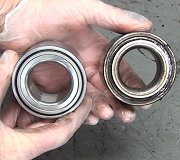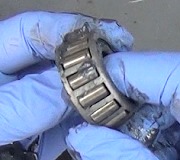Why did it originally need to be replaced? Most often it's because they became noisy. A noisy wheel bearing sounds like an airplane engine. There's no problem driving it like that until you can't stand the noise any longer.
There's two things to consider with a new noise. The first is whether your model uses a splash shield behind the brake rotor. Most vehicles do, and when they're made from stamped sheet metal, it's not too difficult to bend one, then it can scrape against the brake rotor. You'll often be able to hear that at real low speeds, but you might need to have the window open and listen to the echo from a building you're passing. You may no longer hear that at higher speeds, and it could come and go depending on which way you're turning, especially at higher speeds.
A less-known cause of a noisy wheel bearing has to do with improper installation procedures or from some other service. Specifically, there must never be any vehicle weight on that bearing any time the axle nut is not tightened to specs. The torque spec for that nut is very high and must be set with a click-type torque wrench. The axle and wheel bearing will want to rotate when tightening that nut. A lot of competent do-it-yourselfers will install the wheel and tire, set the tire on the ground to hold the axle from spinning, then tighten the axle nut. By that time the damage has already been down. The bearing can be driven on, but it became noisy the instant the weight was on it without that nut being tightened.
A simple step is to stick a punch or screwdriver into one of the cooling slots of the brake rotor, then tighten the axle nut. Once that is done, it's okay to set the vehicle down on the tire.
Another common mistake is to replace the wrong bearing assembly. The noise can sound like it's coming from one side, but it's actually being developed by the bearing on the other side, then that noise is transmitted to the other side where it is heard. There's two common ways to verify which bearing is noisy. My preferred method is to run the vehicle in gear on a hoist, then listen next to each one with a stethoscope. You'll question one, but then the other one will be a real lot louder.
The other method is to raise the front tires off the ground, support the vehicle with jack stands, reach over the top of the tire and wrap your fingertips over part of the coil spring. Rotate the tire with your other hand. You'll feel the vibration in the coil spring on the side with the noisy wheel bearing.
Here's links to some articles that may provide more information:
https://www.2carpros.com/articles/jack-up-and-lift-your-car-safely
https://www.2carpros.com/articles/car-howling-noise
https://www.2carpros.com/articles/whirring-sound
Let me know what you come up with.
Thursday, May 4th, 2023 AT 4:57 PM



